Accept all cookies Accept only essential cookies See our Cookie Notice

About ESA
The European Space Agency (ESA) is Europe’s gateway to space. Its mission is to shape the development of Europe’s space capability and ensure that investment in space continues to deliver benefits to the citizens of Europe and the world.
Highlights
ESA - United space in Europe
This is ESA ESA facts Member States & Cooperating States Funding Director General Top management For Member State Delegations European vision European Space Policy ESA & EU Responsibility & Sustainability Annual Report Calendar of meetings Corporate newsEstablishments & sites
ESA Headquarters ESA ESTEC ESA ESOC ESA ESRIN ESA EAC ESA ESAC Europe's Spaceport ESA ESEC ESA ECSAT Brussels Office Washington OfficeWorking with ESA
Business with ESA ESA Commercialisation Gateway Law at ESA Careers Cyber resilience at ESA IT at ESA Newsroom Partnerships Merchandising Licence Education Open Space Innovation Platform Integrity and Reporting Administrative Tribunal Health and SafetyMore about ESA
History ESA Historical Archives Exhibitions Publications Art & Culture ESA Merchandise Kids Diversity ESA Brand Centre ESA ChampionsLatest
Space in Member States
Find out more about space activities in our 23 Member States, and understand how ESA works together with their national agencies, institutions and organisations.
Science & Exploration
Exploring our Solar System and unlocking the secrets of the Universe
Go to topicAstronauts
Missions
Juice Euclid Webb Solar Orbiter BepiColombo Gaia ExoMars Cheops Exoplanet missions More missionsActivities
International Space Station Orion service module Gateway Concordia Caves & Pangaea BenefitsLatest
Space Safety
Protecting life and infrastructure on Earth and in orbit
Go to topicAsteroids
Asteroids and Planetary Defence Asteroid danger explained Flyeye telescope: asteroid detection Hera mission: asteroid deflection Near-Earth Object Coordination CentreSpace junk
About space debris Space debris by the numbers Space Environment Report In space refuelling, refurbishing and removingSafety from space
Clean Space ecodesign Zero Debris Technologies Space for Earth Supporting Sustainable DevelopmentLatest
Applications
Using space to benefit citizens and meet future challenges on Earth
Go to topicObserving the Earth
Observing the Earth Future EO Copernicus Meteorology Space for our climate Satellite missionsCommercialisation
ESA Commercialisation Gateway Open Space Innovation Platform Business Incubation ESA Space SolutionsLatest
Enabling & Support
Making space accessible and developing the technologies for the future
Go to topicBuilding missions
Space Engineering and Technology Test centre Laboratories Concurrent Design Facility Preparing for the future Shaping the Future Discovery and Preparation Advanced Concepts TeamSpace transportation
Space Transportation Ariane Vega Space Rider Future space transportation Boost! Europe's Spaceport Launches from Europe's Spaceport from 2012Latest

Herschel’s view of NGC 1097
Thank you for liking
You have already liked this page, you can only like it once!
Portrayed in this image by ESA’s Herschel observatory is NGC 1097, a barred spiral galaxy located some 50 million light-years from us, in the southern constellation Fornax, the Furnace.
The blue regions sprinkled across the galaxy’s two spiral arms are sites of intense star formation. There, the energy from newborn stars has heated up the dust interspersed in the interstellar gas, making it glow at the far-infrared and submillimetre wavelengths probed by Herschel.
The dwarf elliptical galaxy NGC 1097A, a small satellite of NGC 1097, can be seen as the fuzzy blue blob in the top right, halfway between the two spiral arms.
The bright core of the NGC 1097, surrounded by a glowing ring where most of the galaxy’s prodigious star formation is taking place, conceals a supermassive black hole about a hundred million times the mass of our Sun. This black hole is devouring matter from its vicinity, causing the galactic core to shine brightly across the electromagnetic spectrum, from X-rays to radio waves.
This galaxy was discovered – and originally identified as a nebula – in the late 18th century in optical observations by William Herschel, the astronomer after whom the observatory is named. Despite the source’s location in the southern sky, it was still visible a few degrees above the horizon at the site in England where Herschel made his observations.
This three-colour image combines Herschel observations at 70 and 100 microns (blue), 160 and 250 microns (green), and 350 and 500 microns (red). North is up and east to the left.
The Herschel Space Observatory was launched on 14 May 2009 and observed the sky for almost four years, until its coolant ran out on 29 April 2013.
Full story: Herschel’s chronicles of galaxy evolution
-
CREDIT
ESA/Herschel/NASA/JPL-Caltech; acknowledgement: R. Hurt (JPL-Caltech) -
LICENCE
CC BY-SA 3.0 IGO or ESA Standard Licence
(content can be used under either licence)
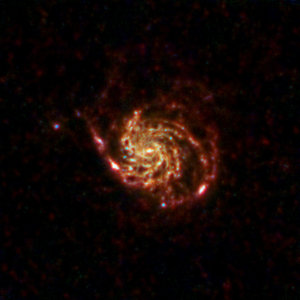
Herschel’s view of the Pinwheel Galaxy
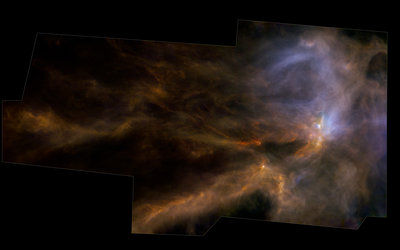
Herschel’s view of a star nursery
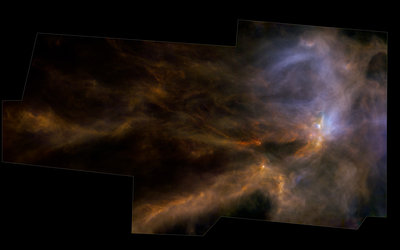
Rho Ophiuchi star-forming region
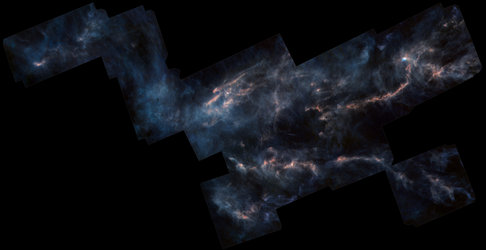
Herschel’s view of the Taurus molecular cloud
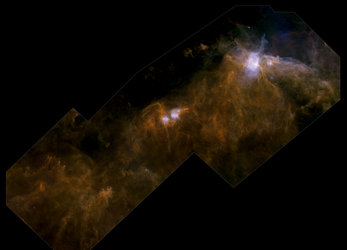














 Germany
Germany
 Austria
Austria
 Belgium
Belgium
 Denmark
Denmark
 Spain
Spain
 Estonia
Estonia
 Finland
Finland
 France
France
 Greece
Greece
 Hungary
Hungary
 Ireland
Ireland
 Italy
Italy
 Luxembourg
Luxembourg
 Norway
Norway
 The Netherlands
The Netherlands
 Poland
Poland
 Portugal
Portugal
 Czechia
Czechia
 Romania
Romania
 United Kingdom
United Kingdom
 Slovenia
Slovenia
 Sweden
Sweden
 Switzerland
Switzerland
























